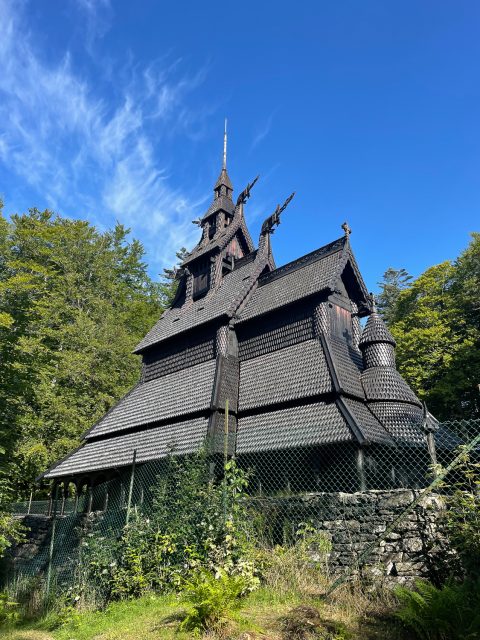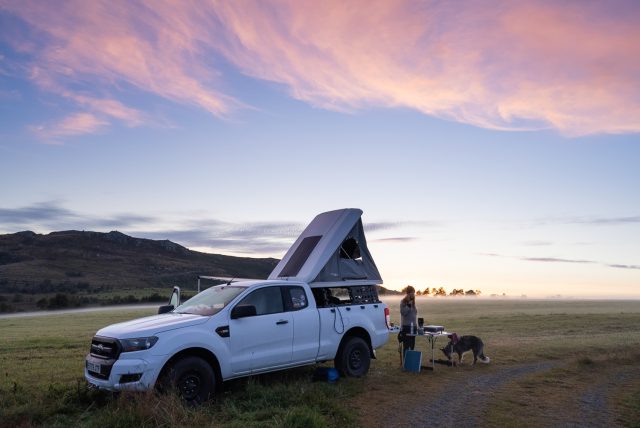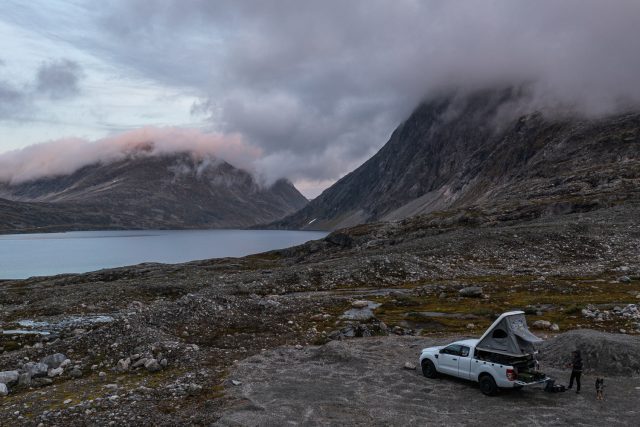For as long as I can remember, Scandinavia has held a particular magnetism for me. In my teenage days, I dreamed of the vast snow dunes of Lapland, fire crackling in the unforgiving cold, the northern lights showing the way through the endless night. The first time I traveled solo, I looked for the landscape from my vision in the grim Icelandic winter. There, I found a boundless love and fondness for everything Scandinavian, a feeling that drives me to come back to these lands time and time again. Above all, I found my now-husband, Enrique, a companion in travel and life who shares the same sentiment. No matter where we go, we’re bound to return to the place that, in a sense, holds our roots.
Norway, and Norwegians, have a bit of a reputation in other European countries, more so in the southern areas of the continent. In Spain, where I’m based, Scandinavia unmistakably invokes a particular picture: cold, well-off, and, nicely put, peculiar. We set out to spend three weeks exploring the fjords on Norway’s southern coast, fixated on the country’s breathtaking landscapes but not expecting much in terms of cultural encounters. Instead, we were surprised to discover variegated societal nuances in a place that alternated between being very similar and very different to our way of living.

Aurlandsfjellet scenic road. It’s a road full of contrasts, connecting the shore with high mountains and snow patches that are visible all year round.
From the moment we stepped off the ferry onto Norway’s southern edge, we were struck by the scenery and the modifications or enhancements to the landscape. Scandinavia is known for its minimal, functional design and innovative architecture that blends seamlessly with nature. In a way, this principle also applies to roads; human intervention is visible everywhere, but somehow it doesn’t diminish or interfere with the landscape.
There are no highways to be found, at least not highways as we understand them—main thoroughfares usually have two lanes and a speed limit of 70 kph (44 mph). On the way south, towards the fjordlands, roads are asphalted and in good condition; however, they are steep and meandering and usually have a single lane, just wide enough for one vehicle. Consequently, traffic jams and elaborate reversing maneuvers are constant. Many roads are marked as too narrow for vehicles beyond a certain length, effectively banning motorhomes from many places. Needless to say, almost all traffic depends on the weather conditions. The chaos creates an unexpected harmony; asphalt winds slowly through the scenery like a river, taking away nothing from the wild nature it conquered.

Sirdal. The road snakes through desolate, rugged scenery dotted with mossy cliffs and small lakes.
The color palette is unmistakable, the terrain painted with the greens of the trees and the ground, the blues of the sky and the still lake waters, the whites of faraway mountain tops. This calm is interrupted only now and then with the typical Scandinavian architecture—small huts with mossy roofs and facades bursting with red, yellow, and orange. It feels like driving through a painting.
All You Can Visit: Fjords, Scenic Routes, and Secret Spots
Despite being relatively small, Norway has the world’s second-longest coastline, just after Canada. This is entirely owing to the fjords that make up its jagged shores. Fjord is an old Norse word, so it’s no surprise that the most famous and scenic examples of this striking natural formation are found here. With more than a thousand of them to choose from, travelers will enjoy dramatic backgrounds complementing all kinds of outdoor activities. Vikings were warriors, traders, and sailors, so naturally, many of their settlements sprang up on the ocean shores. Accordingly, the fjordlands are replete with archeological sites from pagan times, along with the latter-day stave churches.

Bergen’s Fantoft stave church is the only place we saw secured with fences and cameras. This is a reconstruction of a 15th-century church that burned down in 1992 under mysterious circumstances.
Today, an overwhelming majority of Norwegians live in cities, but minuscule settlements remain on the shore, with only a few houses each and no roads or cars in sight. In this day and age, it’s hard to imagine living this way, in one of the most developed countries in the world, completely cut off from your surroundings, relying solely on your neighbors and a small service ferry passing twice a day. Is it an unfortunate remnant of times long gone or a life to strive toward? We can’t decide.
Norway takes extraordinarily good care of its visitors. The publicly financed portal visitnorway.com is an indispensable source of detailed information on anything and everything of remote interest. (My favorite article of theirs is undoubtedly this list of Norway’s finest public toilets.) The website groups together 17 roads as “Norwegian Scenic Routes,” deemed extraordinarily beautiful and worth visiting. We chose these routes whenever possible, and they did not disappoint. Apart from making the journey to sites of interest as enjoyable as the destinations themselves, we often found ourselves in gorgeous, lesser-known places we had all to ourselves.

Lysefjord. A fjord is a long, deep inlet with steep walls formed by a retreating glacier.
Norway: The Freedom to Roam
Like all Scandinavian countries, Norway has a system of laws called allemannsretten (“freedom to roam” or “everyman’s right”) that guarantees free access to public or privately owned wilderness for recreation purposes. These spaces are ours to enjoy, and as long as you don’t damage anything or disturb anyone, you’re free to park wherever you like (if arriving by road), set up camp, and light a fire. There is a catch: allemannsretten explicitly forbids off-trail driving, defining it as a disruptive activity. Off-road activities are reserved for designated dirt and gravel tracks that can be found almost anywhere.
However, fjordlands can be deceiving. While allemannsretten applies here as well, an overlander will inevitably face two problems: Between the fjords’ steep walls and winding roads, there is a scarcity of appropriate camping spots; and Many other travelers want to experience Norway’s free camping, a luxury not common in most other European countries. Even in a pandemic year, we were surprised to find most spots swarming with campervans and motorhomes. Seldom do we run into other overlanders—perhaps they trade the sometimes claustrophobic fjordlands for deserted open spaces in the interior of the peninsula. As determined as we were to explore the fjords, it was obvious that we would, inevitably, follow in their tracks.

Glacier Park on Bondhus Lake. The popular sites might get crowded, but there are lesser-known and equally beautiful spots around every corner.

Once the shore is left behind, open space abounds, and it’s easy to find a place to camp. The farm we chose seemed deserted only during the day. As soon as night fell, we were overwhelmed with cows lowing, loudly and passionately, seemingly from all directions. To complete the eerie atmosphere, the fog came down at dusk; by sunrise, it was so thick it felt almost solid.
Off-Roading in Norway
The practice of off-roading is heavily regulated: trails are usually equipped with a toll booth and so well maintained that vans, campers, and sedans are a common sight. Difficulty and spontaneity are sadly lacking, as the only way to get to these tracks is to specifically go looking for them. We found our way to several trails, where we discovered large surfaces of empty, undisturbed land, desolate rocky hills and their resilient vegetation, and deep blue ponds and their icy freshwater—with no visitors in sight.
The toll system is like nothing we have seen before. Each trailhead has a simple wooden booth showing prices for different types of vehicles and offering methods of payment, either through a local money transfer app or by placing cash in an envelope and sliding it into a mailbox. No personnel run the booths; there are no tickets, no ramp. The visitor is expected and trusted to follow the rules and pay the fee.

Svarta lake in Matre is the prize waiting at the end of a dirt trail. The night spent here was freezing, but the starry skies made up for the cold.
Even though it was present everywhere, this system never ceased to baffle us. More than once, we discussed the action of simply not paying, considering potential controls or repercussions that could take place. Mostly, we talked about how nothing similar could exist in most other places on Earth. The culture of social trust is ingrained so deeply into the Scandinavian mentality that people are happy to pay extravagantly high tolls, taxes, or fees, confident that the money paid to the state will be used for improving their experience as citizens. We find it perplexing but respect the norms nevertheless.

Nærøyfjord, a branch of Sognefjord, nicknamed the King of Fjords, the longest and deepest fjord in Norway.
Organized Freedom
Norway is one of the most expensive places on the globe. But this is, in part, what makes it attractive to overlanders—relying on your vehicle for accommodation, meals, and transport will significantly cut your travel costs. We decided to go to Norway precisely because our way of traveling is not extravagant; our necessary daily costs include fuel and fresh vegetables. Despite our minimal spending, prices slowly wore us down.
On top of the high prices, the food is bland, and even the vegetables are tasteless; we survived on gas station coffees, a peculiar brown goat cheese that tastes like caramel, and endless supplies of fresh fish. A significant chunk of our budget was spent on swimming pools, although we couldn’t possibly regret these expenses. When we went for showers, we didn’t miss the opportunity to enjoy the luxurious saunas, Turkish baths, and hot tubs available at every bathhouse.


Scandinavia’s brand of “organized freedom” is desirable until it’s not, admirable until it touches on a subject you’d have regulated differently. We found ourselves itching for some more serious off-road driving. More than once, too, we reluctantly noted the coldness of the people we crossed paths with and the distance kept, both physically and in conversation. But this cold, radical individualism is part of the region’s charm and why we visited in the first place. We still enjoyed this adventure to the fullest, and all possible lacks were easily compensated for with breathtaking sunrises, invigorating weather, and the general social trust felt at every corner. Norway, it was a pleasure. Thanks for all the fish.

Stalheim. The landscape is rocky and desolate, the grays of the stone in perfect contrast to the bright blue of the cloudless sky. The trail is a service road for a quarry, leading to a beautiful hidden waterfall in the middle of nowhere—a waterfall without a name, invisible on the map.
Want to read more about overlanding Norway, check out Video of the Week :: Overlanding Norway.
Our No Compromise Clause: We carefully screen all contributors to ensure they are independent and impartial. We never have and never will accept advertorial, and we do not allow advertising to influence our product or destination reviews.


